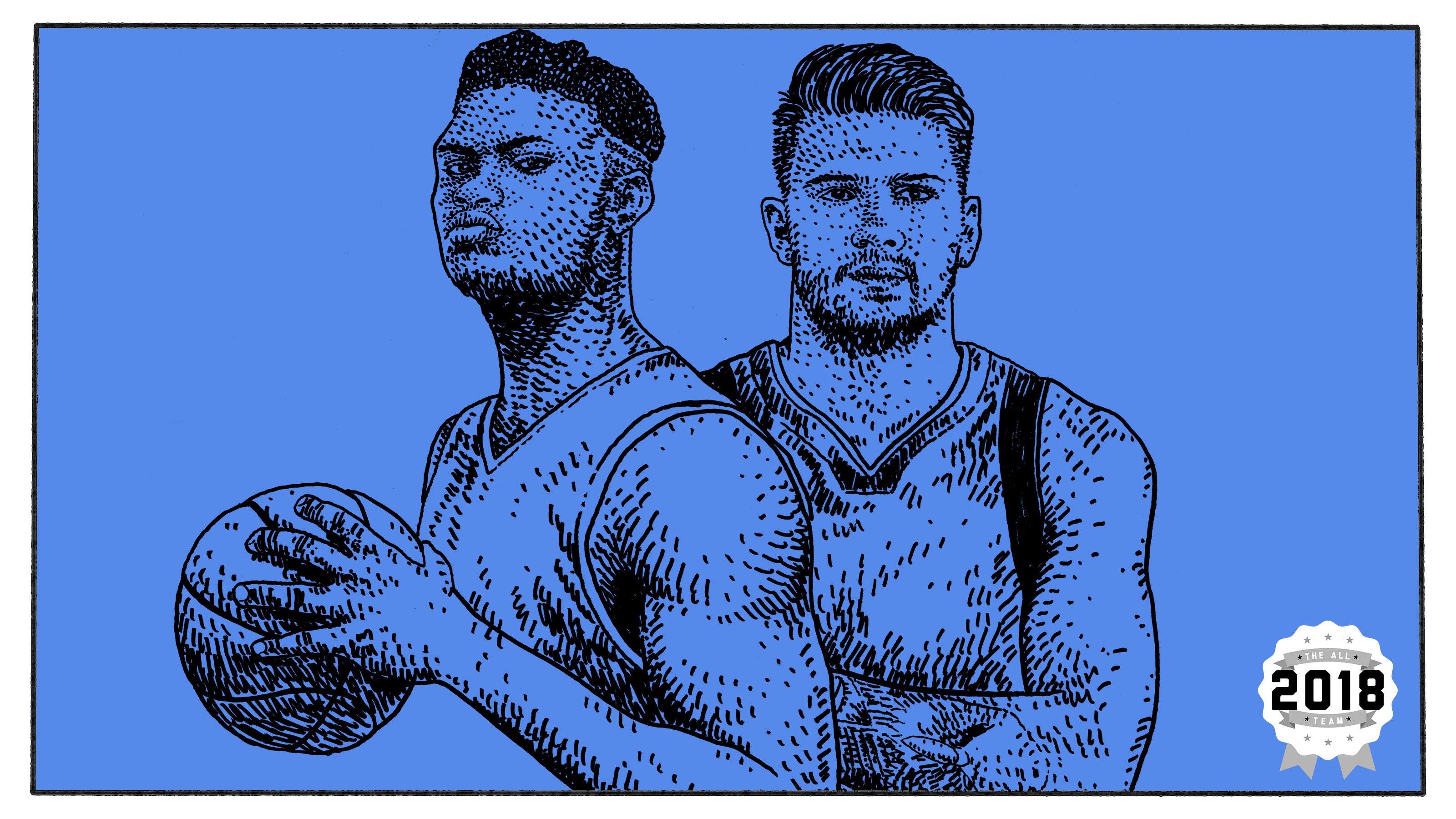Stars Born of YouTube Mixtapes
2018 will be remembered in basketball circles as the year when two highlight heroes—Zion Williamson and Luka Doncic—went mainstreamThere are athletic prodigies whose origin stories feel lifted straight from comic books, whose lives and transformations seem to imitate art in ways that are almost too on-the-nose. Before Anthony Davis became a 6-foot-10 omnipositional destroyer, he was an unheralded 6-foot-2 high school sophomore guard with only one Division I scholarship offer; before J.J. Watt cemented his place as one of the best defensive football players in history with an impossible 295 pounds of muscle tacked onto his 6-foot-5 frame, he was a lanky, underdeveloped two-star high school tight end with a case of mononucleosis. These are our real-life Captains America. These are also the stories I think of when I think about Zion Williamson, who, at the age of 18, is shattering college basketball records in efficiency, and just might be Kentucky-era Davis in present-day Watt’s body.
Zion, of course, has his own origin story. He broke his wrist on an on-court spill during his freshman year of high school; he was 6-foot-3 and 175 pounds, no bigger than Davis was at the same age. X-rays revealed that his growth plates were still open, that he still had room to grow. Boy, did he. By the age of 15, Williamson had shot up three inches and gained more than 50 pounds. He was a big, strong, and springy wing—roughly the size of Clippers 2007 first-rounder Al Thornton, with comparable athleticism. His explosiveness would have met the standards of the NBA’s upper echelon even then, but looking back, knowing what we know now, it’s clear he wasn’t yet Zion.
The first video of Williamson put on YouTube was published in February 2015; his first full-on mixtape was published roughly an entire year later. His gait was labored and choppy; his vertical explosions appeared subdued. He would soon learn that they were. Growing pains in his back and knees were stifling his potential. And then, things stopped hurting.
“Once the pain went away,” Williamson told The Charlotte Observer in 2016, “I picked up all this newfound athleticism. I don’t know where it came from. I just accepted it. Now, I had my ballhandling and size, and the power forwards and small forwards who tried to guard me, I could fly by them.” Stan Lee and Jack Kirby couldn’t have scripted Zion’s rise any better than puberty did.
Last year, Ballislife published a Williamson highlight reel titled, “Zion Williamson is the Best Mixtape Player of our Generation!! The Next Lebron!?” It has more than 1.8 million views. Before stumbling upon the video, it hadn’t occurred to me that the term mixtape player had been in existence long enough for people to begin delineating eras. That first clip of Zion’s dunks published in February 2015 arrived just one year after a mixtape declared then-sophomore Thon Maker a revolutionary 7-footer, and only one week after Maker made the decision to reclassify to the high school class of 2015. Maker’s mixtape was a product of imagineering; his theoretical ability to shoot 3s and execute crossovers at his height offered a window into a world where Kevin Durant acolytes grow on trees. Williamson’s best mixtapes, on the other hand, are simultaneously much more obvious and much harder to place. A player with that kind of size, with that kind of comfort handling the ball, with that kind of athleticism—when the first sensible comparison that comes to mind is LeBron James, hype becomes an impediment to the truth.
But what other truth is there with Zion? Since the age of 16, he has been crashing down like an asteroid, with an almost inexplicable fusion of diametrically opposed skill sets: He has the girth of the biggest centers the NBA has ever seen, but with the propulsive burst of a lithe, aerodynamic athlete like Zach LaVine. It would be misleading to say that Zion himself is aerodynamic, however; his build doesn’t facilitate his aerial ability so much as glitch our perception of it. His body seems to bully gravity into submission the same way he tosses opponents around like rag dolls on the ground. In the past two years, he has fielded comparisons to LeBron James, Charles Barkley, and Larry Johnson, but as far as intrigue goes, he is the type of physical anomaly the league hasn’t seen since Yao Ming.
Zion might be the biggest physical anomaly in basketball, which is saying a lot. It is also probably why, when consensus recruiting rankings for the class of 2018 were compiled, he finished fourth, behind fellow Duke Blue Devils R.J. Barrett and Cam Reddish, and North Carolina Tar Heel Nassir Little. Zion is a startling phenomenon, and most are still coming to terms with who he is as a player. He is a prospect of scarce precedent, whose unreal displays of athleticism pigeonholed him as a gimmick. The hype added more to Zion’s burden of proof than any other prospect in the world. Well, maybe except for one.
The oldest publicly available footage of Luka Doncic dates back to February 2012, from the Spanish ACB’s U-14 Minicopa del Rey, an eight-team youth tournament in Barcelona. Doncic had only just turned 13 then; he traveled to Spain on loan from Olimpija Ljubljana, where he’d completely dominated every age group since he was 8 years old, specifically to play in the Minicopa for Real Madrid’s youth team. He spoke no Spanish, and was one of the youngest players in the tournament. Nonetheless, he was the biggest standout of the tournament (he’d win Minicopa MVP honors the following year). The gangly Doncic commandeered a 103-46 Real Madrid rout of Lucentum Alicante not by scoring, but by passing; his seven assists in that Day 2 match were a tournament high, and more than a number of teams were able to log over the course of an entire game.
Less than two months later, at the Lido di Roma international youth basketball tournament, he put together his star-making performance: a 54-point triple-double for Olimpija Ljubljana in the championship game. It was a game that established a new trajectory for Doncic: He wasn’t just one of the most promising young talents in Slovenia, but one of the most promising talents in the world. From the stands in that Roman gymnasium, you could hear prepubescent teens chanting Luka’s name. Their hero was also a peer.
There are moments in these YouTube reels from Doncic’s early teens that stand out. His knack for tossing heat-seeking, long-distance passes was evident even at 13, before he had the strength to lob them with the ease he does today. At the 2012 U-14 Minicopa, Doncic scored over an opposing center with a sweet up-and-under finger roll that would have felt like a spiritual homage to Julius Erving’s reverse layup around Kareem Abdul-Jabbar in the 1980 NBA Finals if Dr. J’s iconic acrobatics hadn’t occurred two decades before Luka was born. Doncic plays with such self-assuredness, it can seem as though he’s played the same way his entire life. Indeed, that might be the most impressive thing about Luka’s play at any level: From then until now, precious little has changed in the way he approaches the game. His impeccable stability with wide-splayed legs, his in-out hesitation dribbles, his rocker steps, his cross-court whip passes—they’ve been elements of his game since he was a tween, but refined at each stage, commensurate to his developing physique and the level of athleticism around him. At 17, an age when most American prospects would be playing their junior year of high school, Doncic was coming off the bench in an NBA preseason game, taking future MVP Russell Westbrook off the dribble and holding his own against some of the best talent in the world.
In his decade of organized basketball, across all tiers of competition, Doncic has beguiled audiences with the same moves. His game is a living, breathing evolution flip book, the kind of time lapse that, in any other generation, would have been preserved only by families with a VHS recording obsession. In this generation, however, Doncic’s exponential rise, from Minicopa MVP at 14 to EuroLeague Final Four MVP at 19, was available for anyone to track for themselves. Perhaps that was the problem. Unlike most of the European basketball prodigies that preceded him, Doncic never touted an air of mystery; given the interconnectivity of this age, his five-year contract on one of the best basketball teams in the world at the age of 13, and his experience in international competition as a key cog on the Slovenian national team, Doncic was undoubtedly one of the most accessible prospects in the history of basketball. His dominance over the years carried on in a persistent, perfunctory hum. If familiarity didn’t breed contempt, it bred a sort of Holmesian skepticism: “There is nothing more deceptive than an obvious fact.” Doncic was drafted third overall in the 2018 NBA draft. Two months into the season, it’s been difficult for even NBA head coaches to talk about the draft class without first expressing their awe at Doncic’s performance.
It’s the end of 2018, and the NBA seems to be standing on the precipice of something. The league has never been more efficient offensively, and is operating at a pace of play that hasn’t been seen in three decades. The Warriors may win their fourth championship in five years in spite of themselves, but seem destined to lose Kevin Durant this summer in the process. With the departure of LeBron James, the Eastern Conference is one giant bucket of crabs jostling for supremacy; with James’s arrival, the Lakers have become one big timeshare pitch aimed at the league’s biggest stars. The NBA has been held up in the status quo for years, but that sense of sameness is slowly beginning to deteriorate. It’s time to look toward the future.
I’ll choose to remember the year through Zion and Luka, who needed all of a couple of weeks at their new digs in Durham and Dallas, respectively, to show the world that they could be two of the defining players of the NBA’s next decade. They are two of the players who best represent the 20-car pileup along the positional spectrum these days, where size, role, and skill are jumbled in an indecipherable mash. Zion is the small-ball 5 from the Draymond Green school of thought, stretched and compressed to its logical extreme; Luka is in some ways more familiar, taking cues from the likes of James Harden, Larry Bird, and Lamar Odom as a point forward who has more freedom and space to express his gifts than in any previous era. Their biggest strengths and weaknesses as players and their respective rises to prominence could not be more different, but both Williamson and Doncic found themselves as victims and beneficiaries of a hype-driven economy whose best practices don’t always account for true anomalies in the system. In 2018, two of the biggest basketball phenoms of this century answered the biggest questions surrounding them to date. Tracing their respective journeys from the beginning is a way of putting it all in perspective.


